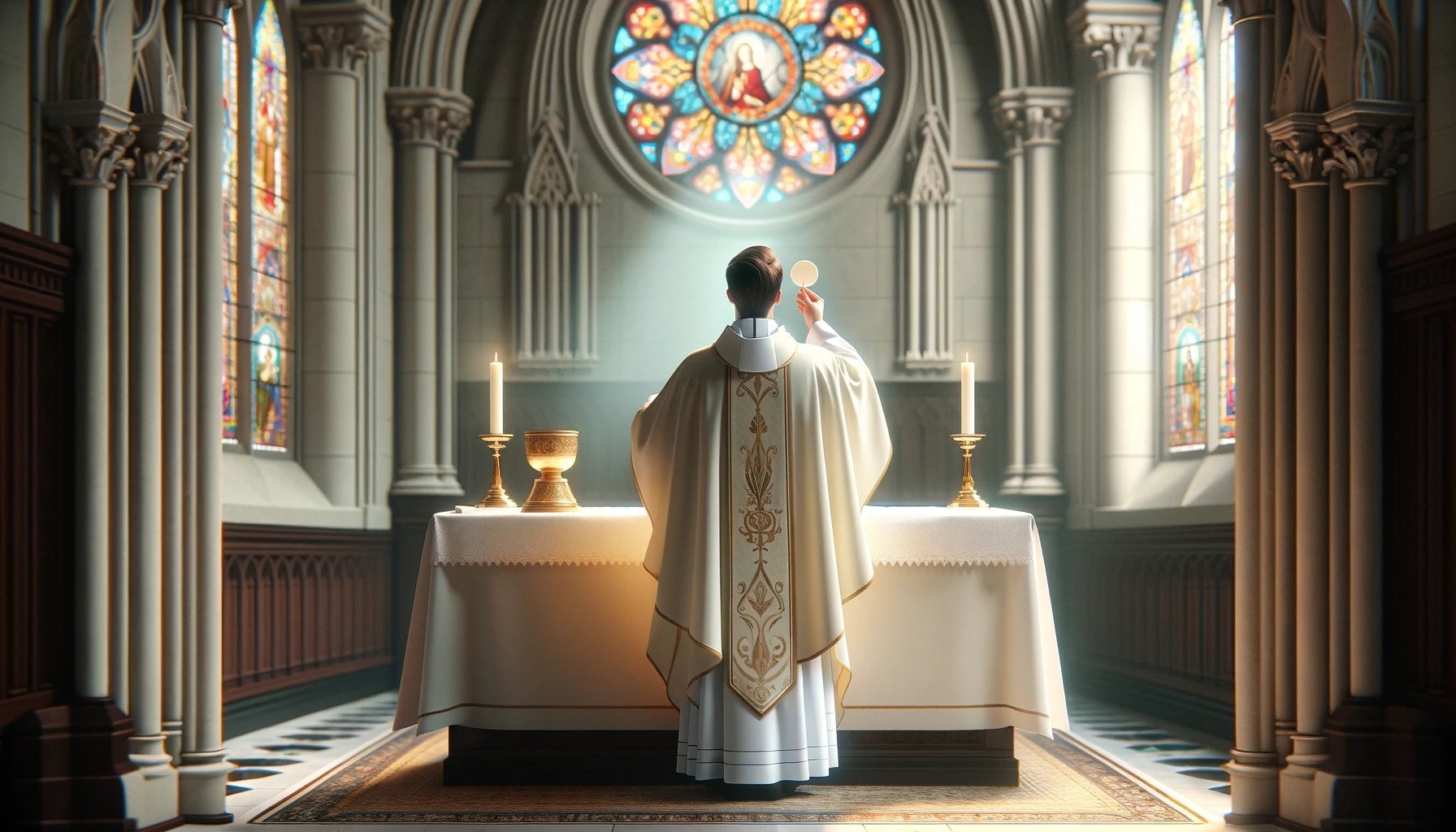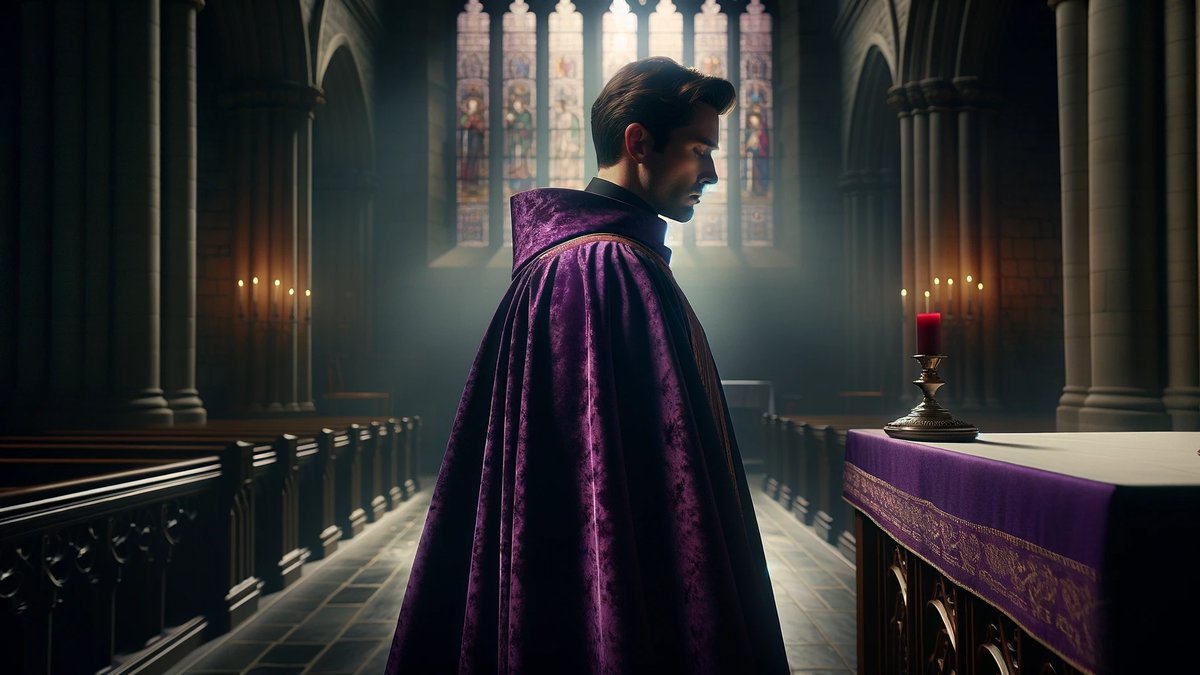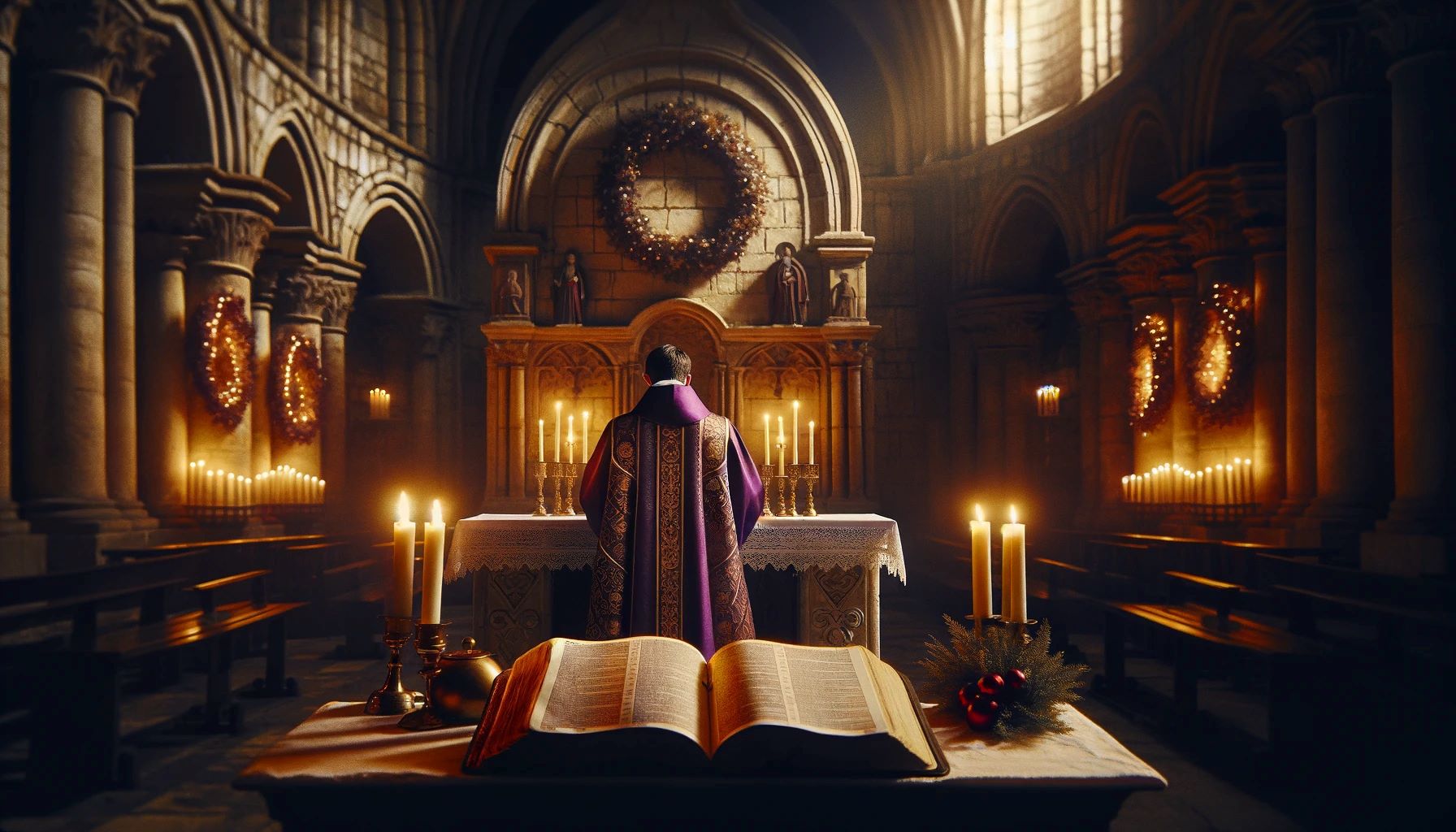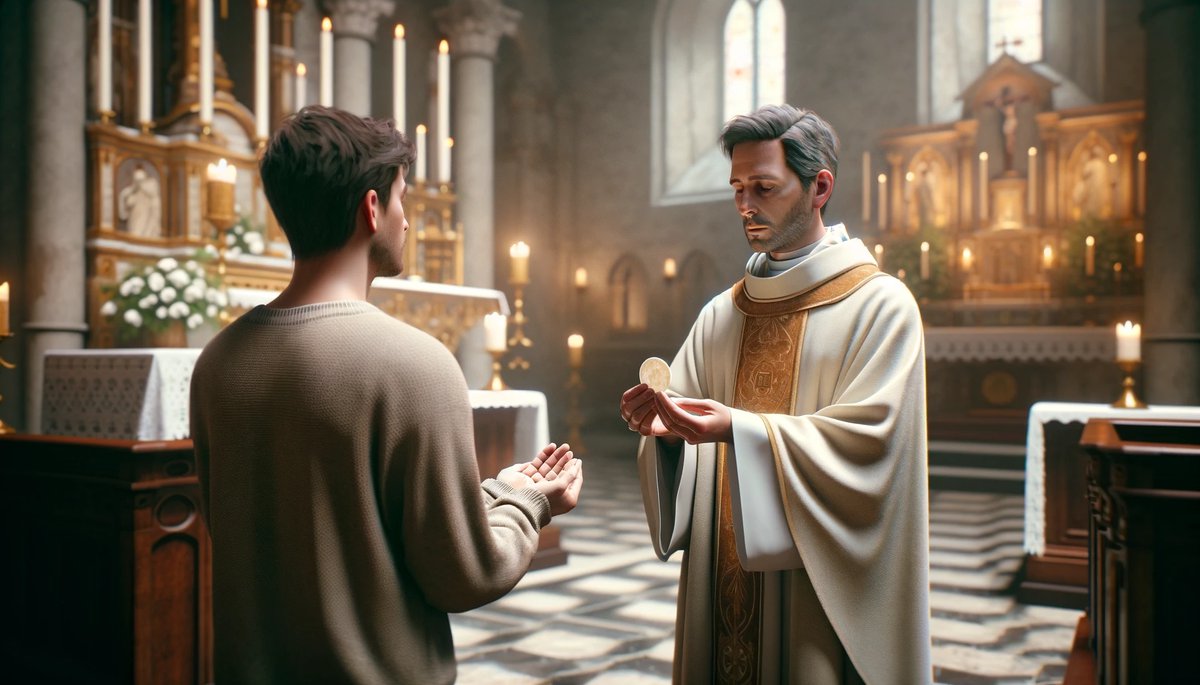Home>Theology and Spirituality>What Does The Priest Say At Communion


Theology and Spirituality
What Does The Priest Say At Communion
Published: February 19, 2024
Ericka Andersen, an editor at Christian.net, expertly merges digital strategy with content creation, focusing on faith and societal issues. Her communication skills enhance the platform's engaging narratives, fostering meaningful dialogue on belief's impact on society.
Discover the significance of the priest's words during communion and deepen your understanding of theology and spirituality with this insightful guide.
(Many of the links in this article redirect to a specific reviewed product. Your purchase of these products through affiliate links helps to generate commission for Christian.net, at no extra cost. Learn more)
Table of Contents
Introduction
The moment of Communion during a religious service is a sacred and profound experience for many believers. It is a time when the congregation comes together to partake in the Eucharist, symbolizing the unity and spiritual nourishment found in the body and blood of Christ. As the faithful approach the altar to receive the consecrated bread and wine, there are several significant elements and prayers that contribute to the rich tapestry of this ritual.
The priest, as the spiritual guide and facilitator of the Communion, plays a pivotal role in leading the congregation through this sacred act. Their words and actions carry deep significance, serving to guide and unite the faithful in this communal expression of faith and devotion. Understanding the words spoken by the priest at Communion can provide insight into the spiritual significance of this sacred moment and deepen one's connection to the divine.
Throughout the Communion service, the priest's words serve as a bridge between the congregation and the divine, guiding the faithful through the various stages of the ritual with reverence and solemnity. From the exchange of the Sign of Peace to the reception of the Eucharist, the priest's words and gestures create a sense of reverence and unity, fostering a profound spiritual experience for those in attendance.
As we delve into the specific prayers and invocations spoken by the priest during Communion, we will uncover the deep spiritual symbolism and significance imbued within each utterance. By gaining a deeper understanding of the priest's words at Communion, we can enrich our own spiritual journey and cultivate a greater appreciation for the profound mysteries encapsulated within this sacred sacrament.
Read more: What Does The Priest Say After Confession
The Sign of Peace
The Sign of Peace, also known as the "Kiss of Peace" in some traditions, is a poignant and symbolic moment during the Communion service. This exchange of peace and unity among the congregation reflects the profound interconnectedness and love that underpins the Christian faith. As the priest initiates this gesture, the congregation is invited to extend a sign of peace to one another, fostering a sense of harmony and goodwill within the community of believers.
The priest's words during the Sign of Peace serve as a gentle prompt, encouraging the congregation to embody the spirit of reconciliation and fraternity. With a heartfelt invocation such as "Let us offer each other the sign of peace," the priest guides the faithful to turn their attention to their fellow worshippers, acknowledging the shared humanity and divine grace that unites them.
In response to the priest's invitation, the congregation engages in a profound exchange of gestures and words, expressing their desire for peace and unity within the community. Handshakes, embraces, and words of goodwill are shared among the worshippers, creating a palpable atmosphere of warmth and solidarity. This exchange transcends mere social custom; it embodies the spiritual essence of forgiveness, reconciliation, and love that lies at the heart of the Christian message.
The Sign of Peace holds deep theological significance, echoing the biblical exhortation to "love one another as I have loved you." It serves as a tangible expression of the reconciliation and harmony that Christ's sacrifice has made possible, inviting the faithful to embody these virtues in their interactions with one another. Through this exchange, the congregation reaffirms their commitment to fostering peace and goodwill within their community, reflecting the transformative power of Christ's teachings in their lives.
As the priest observes the congregation engaging in this exchange, their presence serves as a focal point, guiding and sanctifying this sacred moment. Their words and demeanor convey a sense of reverence and solemnity, underscoring the spiritual significance of the Sign of Peace within the context of the Communion service.
In essence, the Sign of Peace, guided by the priest's gentle invocation, serves as a poignant reminder of the transformative power of love and reconciliation within the Christian faith. It stands as a testament to the enduring message of unity and compassion that lies at the core of the Communion ritual, enriching the spiritual experience of the faithful and fostering a profound sense of communal harmony and grace.
The Fraction Rite
The Fraction Rite, a pivotal moment within the Communion service, holds deep spiritual significance and symbolism. This sacred ritual occurs after the Sign of Peace and precedes the distribution of the Eucharist to the congregation. The term "fraction" refers to the breaking of the consecrated bread, mirroring the actions of Jesus during the Last Supper, where He broke bread and shared it with His disciples.
As the priest prepares to partake in the Fraction Rite, they reverently take the consecrated host and, with deliberate and solemn movements, break it into smaller portions. This act of breaking the bread symbolizes the sacrificial nature of Christ's body, which was broken for the salvation of humanity. The priest's actions during the Fraction Rite serve as a poignant reminder of Christ's selfless sacrifice and the redemptive power inherent in His body and blood.
Accompanying the breaking of the bread, the priest may recite a prayer or invocation, further emphasizing the profound spiritual significance of this act. Through their words and gestures, the priest invites the congregation to contemplate the sacrificial nature of Christ's body and to prepare their hearts to receive the Eucharist with reverence and gratitude.
The Fraction Rite also symbolizes the unity of the faithful as one body in Christ. Just as the broken pieces of bread are later distributed to the congregation, each member partakes in the shared experience of receiving the body of Christ. This act of communion underscores the interconnectedness and spiritual unity of the believers, reinforcing the profound bond that transcends individuality and unites them in a collective expression of faith and devotion.
The priest's role during the Fraction Rite is one of solemn reverence and spiritual guidance. Their words and actions convey a sense of awe and reverence, underscoring the sacred nature of the ritual and inviting the congregation to enter into a deeper communion with the divine. Through their gentle and deliberate movements, the priest leads the faithful in a contemplative journey, fostering a sense of spiritual introspection and reverence for the sacred mysteries unfolding before them.
In essence, the Fraction Rite serves as a poignant and symbolic prelude to the reception of the Eucharist, inviting the faithful to reflect on the sacrificial love of Christ and to embrace the profound unity and spiritual nourishment found in the body and blood of the Savior. It stands as a testament to the enduring significance of the Communion ritual, enriching the spiritual experience of the faithful and fostering a profound sense of reverence and unity within the community of believers.
The Invitation to Communion
The Invitation to Communion marks a pivotal moment in the Communion service, where the priest extends a solemn and reverent invitation to the congregation to partake in the Eucharist. This sacred invitation serves as a poignant call to the faithful, beckoning them to approach the altar and receive the body and blood of Christ, symbolizing the spiritual nourishment and unity found in the divine sacrament.
As the priest prepares to extend this profound invitation, the atmosphere within the sanctuary becomes imbued with a sense of reverence and anticipation. With gentle yet resolute words, the priest invites the congregation to partake in the sacred banquet, using language that reflects the profound significance of this act. The invitation serves as a spiritual beckoning, drawing the faithful into a deeper communion with the divine and with one another.
The priest's words during the Invitation to Communion carry a weight of solemnity and grace, underscoring the sacred nature of the Eucharistic feast. Through their gentle and deliberate intonation, the priest conveys a sense of reverence and awe, inviting the congregation to approach the altar with hearts open and spirits attuned to the divine presence. The invitation serves as a bridge between the earthly realm and the transcendent, guiding the faithful towards a profound encounter with the sacred mysteries of the Eucharist.
As the congregation responds to the priest's invitation, a palpable sense of unity and spiritual anticipation permeates the sanctuary. The faithful, moved by the priest's solemn call, approach the altar with a sense of reverence and humility, preparing to receive the body and blood of Christ. The invitation serves as a unifying force, drawing the congregation together in a shared expression of faith and devotion, fostering a profound sense of spiritual communion and unity within the community of believers.
In essence, the Invitation to Communion stands as a testament to the transformative power of the Eucharist, inviting the faithful to partake in the sacred banquet and to experience the profound unity and spiritual nourishment found in the body and blood of Christ. It serves as a poignant and reverent call to the congregation, guiding them towards a deeper communion with the divine and fostering a profound sense of reverence and unity within the community of believers.
The Communion Antiphon
The Communion Antiphon, a sacred and contemplative element of the Communion service, holds profound spiritual significance within the liturgical tradition. This poignant segment occurs as the faithful prepare to receive the Eucharist, marking a moment of spiritual introspection and reverence. The Communion Antiphon typically consists of a psalm or liturgical chant, carefully selected to reflect the themes of unity, spiritual nourishment, and divine communion inherent in the Eucharistic celebration.
As the priest prepares to lead the congregation in the Communion Antiphon, a hushed and reverent atmosphere envelops the sanctuary. The chosen psalm or chant, often drawn from the rich tapestry of sacred music, serves as a poignant invocation, inviting the faithful to enter into a contemplative space of spiritual preparation and receptivity. The priest's gentle intonation of the antiphon sets the tone for this sacred interlude, guiding the congregation towards a deeper communion with the divine through melodic and evocative verses.
The Communion Antiphon serves as a bridge between the preceding moments of the Communion service and the imminent reception of the Eucharist. It offers a space for the faithful to center their hearts and minds, preparing to partake in the sacred banquet with reverence and spiritual attentiveness. The chosen psalm or chant often echoes themes of unity, love, and spiritual nourishment, serving as a poignant reminder of the transformative power encapsulated within the Eucharistic feast.
As the congregation listens to the Communion Antiphon, a sense of spiritual anticipation and contemplation permeates the sanctuary. The melodic strains of the chant or the resonant recitation of the psalm create a sacred ambiance, fostering a profound sense of unity and spiritual receptivity among the faithful. The Communion Antiphon serves as a unifying force, drawing the congregation together in a shared expression of faith and devotion, preparing their hearts to receive the body and blood of Christ with reverence and gratitude.
In essence, the Communion Antiphon stands as a testament to the profound spiritual journey encapsulated within the Communion service. It serves as a poignant and contemplative interlude, guiding the faithful towards a deeper communion with the divine and fostering a profound sense of reverence and unity within the community of believers. Through the melodic beauty and spiritual depth of the Communion Antiphon, the faithful are invited to partake in the sacred banquet with hearts open and spirits attuned to the transformative grace of the Eucharist.
Read more: What Does A Priest Say During Confession
The Reception of Communion
The Reception of Communion marks the culmination of the sacred and reverent journey through the Communion service. As the faithful approach the altar to partake in the Eucharist, a profound sense of spiritual anticipation and unity permeates the sanctuary. The priest, embodying a solemn and reverent presence, guides the congregation through this transformative moment with grace and reverence.
As the faithful approach the altar, the priest, with gentle and deliberate movements, offers the consecrated host to each communicant, uttering the sacred words, "The body of Christ." These simple yet profound words encapsulate the essence of the Eucharistic feast, inviting the faithful to receive the body of Christ with reverence and gratitude. The priest's demeanor and intonation convey a sense of solemnity and grace, underscoring the sacred nature of this act and guiding the communicants towards a profound encounter with the divine.
The reception of the Eucharist is a deeply personal and spiritual experience for each communicant. As they receive the consecrated host from the priest, a palpable sense of reverence and spiritual communion envelops them. The act of partaking in the body of Christ symbolizes the spiritual nourishment and unity found in the Eucharistic feast, fostering a profound sense of spiritual intimacy and communion with the divine.
The priest's role during the reception of Communion is one of spiritual facilitation and guidance. Their words and gestures convey a sense of reverence and grace, creating a sacred space for the communicants to enter into a profound communion with the divine. Through their gentle and deliberate actions, the priest leads the faithful in a transformative journey, fostering a sense of spiritual receptivity and unity within the community of believers.
In essence, the reception of Communion stands as a testament to the transformative power of the Eucharist, inviting the faithful to partake in the sacred banquet and to experience the profound unity and spiritual nourishment found in the body and blood of Christ. It serves as a poignant and reverent culmination of the Communion service, enriching the spiritual experience of the faithful and fostering a profound sense of reverence and unity within the community of believers.
The Prayer after Communion
The Prayer after Communion represents a sacred and contemplative moment that follows the reception of the Eucharist, allowing the faithful to enter into a space of profound spiritual reflection and gratitude. As the congregation has partaken in the body and blood of Christ, the priest leads them in a prayer that encapsulates the essence of the Eucharistic experience and serves as a poignant culmination of the Communion service.
With gentle yet resolute words, the priest guides the congregation in a prayer that reflects themes of thanksgiving, spiritual nourishment, and unity. This prayer serves as a collective expression of gratitude for the transformative grace received through the Eucharist, fostering a sense of reverence and spiritual receptivity among the faithful. The priest's demeanor and intonation convey a profound sense of solemnity and grace, underscoring the sacred nature of this moment and guiding the congregation towards a deeper communion with the divine.
The Prayer after Communion offers a space for the faithful to center their hearts and minds, allowing them to reflect on the profound significance of the Eucharistic feast in their spiritual journey. It serves as a moment of intimate communion with the divine, as the congregation collectively offers their gratitude for the spiritual nourishment and unity found in the body and blood of Christ. The priest's words serve as a spiritual beacon, guiding the faithful towards a deeper understanding of the transformative grace received through the Eucharist and fostering a profound sense of reverence and unity within the community of believers.
As the congregation joins in this collective prayer, a palpable sense of spiritual communion and gratitude permeates the sanctuary. The prayer serves as a unifying force, drawing the faithful together in a shared expression of thanksgiving and devotion, reinforcing the profound bond that transcends individuality and unites them in a collective expression of faith and gratitude. Through the Prayer after Communion, the faithful are invited to embrace the transformative power of the Eucharist and to cultivate a deeper sense of spiritual receptivity and unity within the community of believers.
In essence, the Prayer after Communion stands as a testament to the profound spiritual journey encapsulated within the Communion service. It serves as a poignant and reverent culmination of the Eucharistic experience, enriching the spiritual lives of the faithful and fostering a profound sense of reverence, gratitude, and unity within the community of believers.














